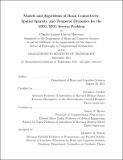Models and algorithms of brain connectivity, spatial sparsity, and temporal dynamics for the MEG/EEG inverse problem
Author(s)
Lamus Garcia Herreros, Camilo
DownloadFull printable version (39.38Mb)
Other Contributors
Massachusetts Institute of Technology. Department of Brain and Cognitive Sciences.
Advisor
Patrick L. Purdon and Emery N. Brown.
Terms of use
Metadata
Show full item recordAbstract
Magnetoencephalography (MEG) and electroencephalography (EEG) are noninvasive functional neuroimaging techniques that provide high temporal resolution recordings of brain activity, offering a unique means to study fast neural dynamics in humans. Localizing the sources of brain activity from MEG/EEG is an ill-posed inverse problem, with no unique solution in the absence of additional information. In this dissertation I analyze how solutions to the MEG/EEG inverse problem can be improved by including information about temporal dynamics of brain activity and connectivity within and among brain regions. The contributions of my thesis are: 1) I develop a dynamic algorithm for source localization that uses local connectivity information and Empirical Bayes estimates to improve source localization performance (Chapter 1). This result led me to investigate the underlying theoretical principles that might explain the performance improvement observed in simulations and by analyzing experimental data. In my analysis, 2) I demonstrate theoretically how the inclusion of local connectivity information and basic source dynamics can greatly increase the number of sources that can be recovered from MEG/EEG data (Chapter 2). Finally, in order to include long distance connectivity information, 3) I develop a fast multi-scale dynamic source estimation algorithm based on the Subspace Pursuit and Kalman Filter algorithms that incorporates brain connectivity information derived from diffusion MRI (Chapter 3). Overall, I illustrate how dynamic models informed by neurophysiology and neuroanatomy can be used alongside advanced statistical and signal processing methods to greatly improve MEG/EEG source localization. More broadly, this work provides an example of how advanced modeling and algorithm development can be used to address difficult problems in neuroscience and neuroimaging.
Description
Thesis: Ph. D., Massachusetts Institute of Technology, Department of Brain and Cognitive Sciences, 2015. This electronic version was submitted by the student author. The certified thesis is available in the Institute Archives and Special Collections. Cataloged from student-submitted PDF version of thesis. Includes bibliographical references (pages 123-131).
Date issued
2015Department
Massachusetts Institute of Technology. Department of Brain and Cognitive SciencesPublisher
Massachusetts Institute of Technology
Keywords
Brain and Cognitive Sciences.